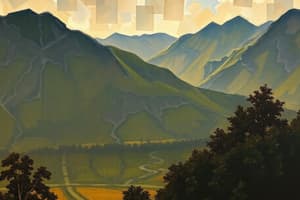Podcast
Questions and Answers
Which of the following focuses on natural phenomena like climate and landforms?
Which of the following focuses on natural phenomena like climate and landforms?
- Population geography
- Cultural landscape theory
- Physical geography (correct)
- Human geography
Human geography studies the spatial distribution of physical features.
Human geography studies the spatial distribution of physical features.
False (B)
What are the two main branches of geography?
What are the two main branches of geography?
Physical geography and human geography
The study of climates and weather patterns is known as ______.
The study of climates and weather patterns is known as ______.
Match the geographic concepts with their definitions:
Match the geographic concepts with their definitions:
Which technology is used to analyze geographic data and reveal spatial relationships?
Which technology is used to analyze geographic data and reveal spatial relationships?
Environmental determinism suggests that human activities are heavily influenced by environmental factors.
Environmental determinism suggests that human activities are heavily influenced by environmental factors.
What does biogeography study?
What does biogeography study?
Flashcards
What is geography?
What is geography?
The study of the Earth's surface, its features, and the processes that shape them.
What is physical geography?
What is physical geography?
The study of natural phenomena, including climate, landforms, soils, water, and ecosystems.
What is human geography?
What is human geography?
The study of the spatial distribution of human activities, such as population, culture, economies, and politics.
What is spatial distribution?
What is spatial distribution?
Signup and view all the flashcards
What is absolute location?
What is absolute location?
Signup and view all the flashcards
What is relative location?
What is relative location?
Signup and view all the flashcards
What is place?
What is place?
Signup and view all the flashcards
What is a region?
What is a region?
Signup and view all the flashcards
Study Notes
Branches of Geography
- Geography is the study of Earth's surface, features, and shaping processes.
- Two main branches: physical geography and human geography.
- Physical geography examines natural phenomena like climate, landforms, soils, water, and ecosystems.
- Human geography studies the spatial distribution of human activities such as population, culture, economies, and politics.
Concepts in Geography
- Spatial distribution: the arrangement of features across space.
- Location: a place's position. Absolute location uses coordinates (latitude and longitude); relative location describes position relative to other places.
- Place: unique characteristics distinguishing a location, including physical and human aspects.
- Region: an area with shared characteristics (climate, culture, or economy).
- Movement: the flow of people, goods, and ideas across space.
Key Elements of Geographic Study
- Maps visually represent geographic data, including topographic maps (elevation) and thematic maps (specific patterns).
- Geographic Information Systems (GIS) analyze and display geographic data, allowing overlaying datasets to understand spatial relationships.
- Remote sensing uses satellites to collect Earth surface data.
- Fieldwork involves direct observation and recording of geographic features.
Geographic Perspectives
- Environmental determinism: the environment strongly influences human activities.
- Possibilism: acknowledges environmental limits, but emphasizes human agency and adaptation shaping landscapes.
- Cultural landscape theory: examines how human actions alter the environment, creating unique cultural landscapes.
Physical Geography Subdivisions
- Geomorphology: studies landforms and Earth surface shaping processes.
- Climatology: investigates climates, weather patterns, and variations.
- Hydrology: studies water distribution and water system dynamics.
- Biogeography: examines the distribution of plants and animals.
Human Geography Subdivisions
- Population geography: studies population distribution, density, and growth.
- Economic geography: explores the spatial organization of economic activities like industry and trade.
- Urban geography: studies cities and urban areas, including their development and features.
- Cultural geography: focuses on the spatial distribution of cultural elements and interactions.
- Political geography: studies the spatial aspects of political systems, elections, and territories.
Interdisciplinary Connections
- Geography connects with other fields (geology, biology, economics, sociology) to understand human-environment interactions.
- Geographic research provides insights into global issues such as climate change, resource management, and urban planning.
Studying That Suits You
Use AI to generate personalized quizzes and flashcards to suit your learning preferences.




